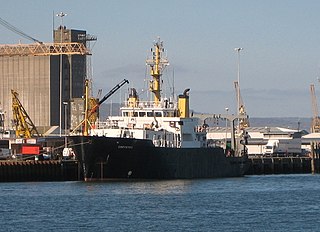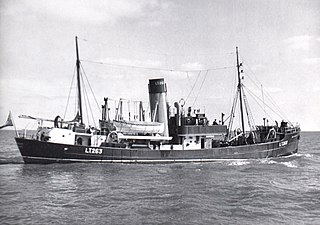
A well smack was a type of traditional fishing boat in use between the late 18th century and around 1920. It had a well amidships. The well was filled with circulated external water, which kept fish alive until delivered to land and sold. It was a modified form of a fishing smack.
The Centre for Environment, Fisheries and Aquaculture Science (Cefas) is an executive agency of the United Kingdom government Department for Environment, Food and Rural Affairs (Defra). It carries out a wide range of research, advisory, consultancy, monitoring and training activities for a large number of customers around the world.

Walter Garstang FLS FZS, a Fellow of Lincoln College, Oxford and Professor of Zoology at the University of Leeds, was one of the first to study the functional biology of marine invertebrate larvae. His best known works on marine larvae were his poems published as Larval Forms and Other Zoological Verses, especially The Ballad of the Veliger. They describe the form and function of several marine larvae as well as illustrating some controversies in evolutionary biology of the time.

The Marine Biological Association of the United Kingdom (MBA) is a learned society with a scientific laboratory that undertakes research in marine biology. The organisation was founded in 1884 and has been based in Plymouth since the Citadel Hill Laboratory was opened on 30 June 1888.

Mincarlo is the last surviving sidewinder fishing trawler of the Lowestoft fishing fleet. She is also the last surviving fishing vessel built in Lowestoft, with an engine made in the town.
The fishing industry in England covers the fish processing industry and fishing trawler companies that fish around England.

RV Corystes is an ocean-going, research vessel operating around Northern Ireland. She is equipped with specialist fishing gear and acoustic techniques for surveys of fish stocks.

RV Cefas Endeavour is an ocean-going fisheries research vessel based at the port of Lowestoft and owned by the Centre for Environment, Fisheries and Aquaculture Science (Cefas).

RV Cirolana was a fisheries research vessel used by the Centre for Environment, Fisheries and Aquaculture Science and originally built for the Ministry of Agriculture, Fisheries and Food. She was initially intended to replace the RV Ernest Holt operating in arctic waters around Bear Island (Norway) and Iceland, but following the Cod Wars spent most of her working life conducting fisheries surveys in the North Sea, Irish Sea and English Channel. For the first part of her career RV Cirolana was based in the fishing port of Grimsby, but after bridge and channel dredging work improved the depth, it was deemed acceptable to bring her to Lowestoft.

RV Sir Lancelot (LT263) was a fisheries research vessel that was operated by the Directorate of Fisheries, now known as the Centre for Environment, Fisheries and Aquaculture Science (Cefas).

RV Ernest Holt (GY591) was a fisheries research vessel that was operated by the Ministry of Agriculture, Fisheries and Food - Directorate of Fisheries, now known as the Centre for Environment, Fisheries and Aquaculture Science (Cefas).

Dorothy Elizabeth Thursby-Pelham (1884–1972) was a scientist at the Zoological Laboratory, University of Cambridge and subsequently at the Ministry of Agriculture, Fisheries and Food - Directorate of Fisheries laboratory in Lowestoft who has been called 'England's first female sea-going fisheries scientist' and was an active member of the International Council for the Exploration of the Sea (ICES).

RV George Bligh (LO309) was a fisheries research vessel that was operated by the Directorate of Fisheries, now known as the Centre for Environment, Fisheries and Aquaculture Science (Cefas).

RV Corella (LT767) was a fisheries research vessel that was operated by the Ministry of Agriculture, Fisheries and Food - Directorate of Fisheries, now known as the Centre for Environment, Fisheries and Aquaculture Science (Cefas) between 1967 and 1983.

RV Clione (LT421) was a fisheries research vessel that was operated by the Ministry of Agriculture, Fisheries and Food - Directorate of Fisheries, now known as the Centre for Environment, Fisheries and Aquaculture Science (Cefas) between 1961 and 1988.

RV Platessa (LT205) was a fisheries research vessel that was operated by the Ministry of Agriculture, Fisheries and Food - Directorate of Fisheries, now known as the Centre for Environment, Fisheries and Aquaculture Science (Cefas) between 1946 and 1967.

SS Joseph & Sarah Miles (LO175) was a ‘mission ship’, constructed for the Royal National Mission to Deep Sea Fishermen and operated from 1902 until 1930. She acted as a hospital ship during the Dogger Bank incident on the night of 21/22 October 1904, when the Russian Baltic Fleet mistook a British trawler fleet for the Imperial Japanese Navy and fired on them in the North Sea.

RV Tellina (LT242) was a fisheries research vessel that was operated by the Ministry of Agriculture, Fisheries and Food - Directorate of Fisheries, now known as the Centre for Environment, Fisheries and Aquaculture Science (Cefas) between 1960 and 1981.
The SY Hildegarde and the SY Hiawatha were steam yachts chartered by the Ministry of Agriculture, Fisheries and Food - Directorate of Fisheries, now known as the Centre for Environment, Fisheries and Aquaculture Science (Cefas) between 1912 and 1914 to carry out fishery investigations.

Michael Graham (1898–1972) CMG OBE was a British fisheries scientist, author, and ecologist. He was the director of the Ministry of Agriculture, Fisheries and Food fisheries laboratory in Lowestoft (1945–1958), now known as the Centre for Environment, Fisheries and Aquaculture Science (Cefas). His classic book, The Fish Gate, published in 1943, paints a picture of the near-collapse of the British fishing industry through overfishing that occurred before both the First and the Second World Wars.

















